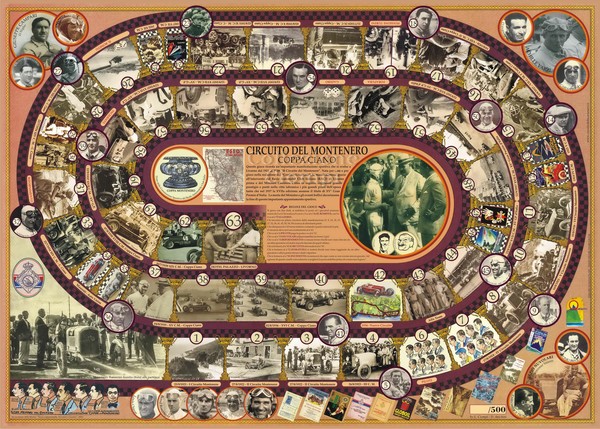
XVII° CIRCUITO DEL MONTENERO
COPPA CIANO - XV GRAN PREMIO D’ITALIA
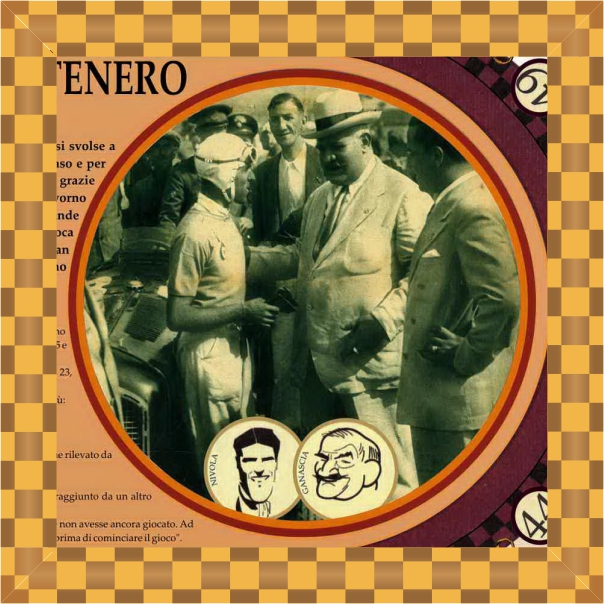
|
||
| Istituto luce |

|
XVII° CIRCUITO DEL MONTENERO
|

|
||
| Istituto luce |
| Introduzione | Articoli | Foto | Classifica e piloti |
Percorso | Pubblicità Pubblicazioni |
Coppa del Mare | Montenero Home |
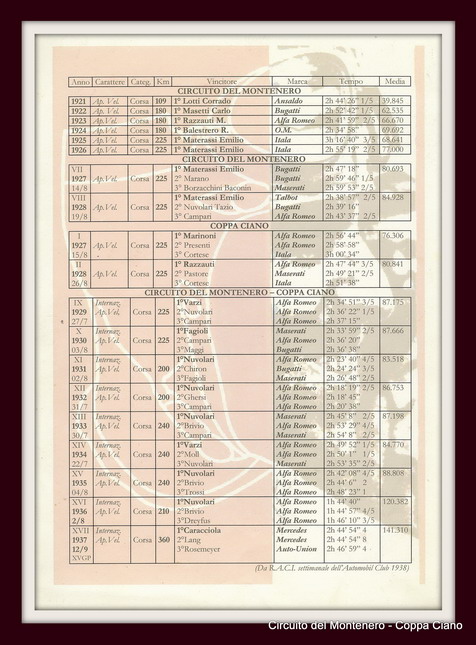
|
1937- 12 settembre Percorso. Lunghezza 7,218 km “XV Gran Premio d’Italia - XVII Coppa Ciano” Formula 1750 kg (50 giri - 360,900 km) 1) CARACCIOLA Rudolf, su Mercedes, in 2h 44’54”2/5 (media 131,310 km/h); 2) LANG Hermann, su Mercedes, in 2h 44’54”4/5; 3) ROSEMEYER Bernd, su Auto Union, 2h 46’19”4/5; 4) SEAMAN Richard, su Mercedes, a un giro; 5) MULLER Hermann Paul, su Auto Union, a un giro; 6) VARZI Achille, su Auto Union, a un giro; 7) NUVOLARI Tazio-FARINA Giuseppe, su Alfa Romeo, a un giro; 8) TROSSI Carlo Felice, su Alfa Romeo, a tre giri; 9) STUCK Hans-HASSE Rudolf, su Auto Union, a tre giri; 10) BELMONDO Vittorio, su Alfa Romeo, a cinque giri; Giro più veloce il 33° di Caracciola Rudolph e Lang Hermann in 3’.11”.1/5 a 135,903 km/h; Ritirati: Farina Giuseppe (Alfa Romeo) al 13° giro; Guidotti Giovan Battista (Alfa Romeo) al 24° giro; von Brauchitsch Manfred (Mercedes) al 36° giro; Biondetti Clemente (Alfa Romeo) al 38° giro; Kautz Christian al 43° giro. (Da: Maurizio Mazzoni: “Lampi sul Tirreno”, Firenze 2006) |
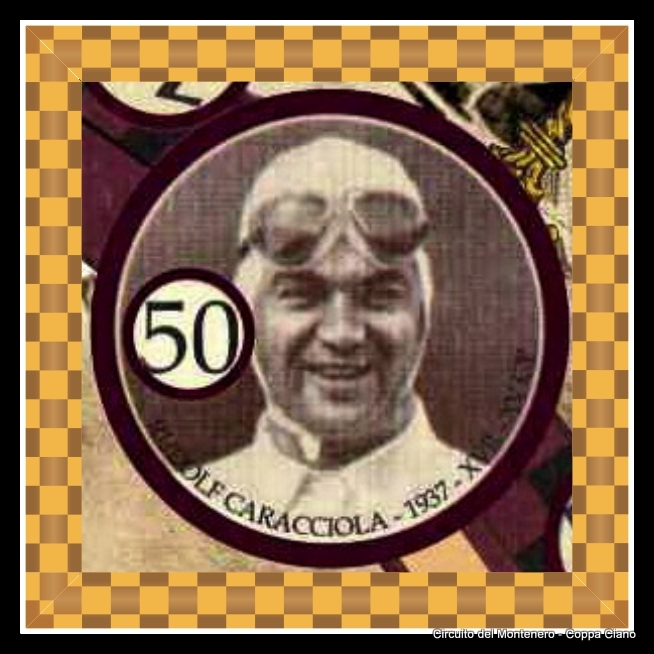
|
|
|
XV° GRAN PREMIO D'ITALIA Livorno, 12 September 1937 50 laps x 7.218 km (4.485 mi) = 360.9 km (224.3 mi) Drivers (N°2) Rudolf Caracciola, (Daimler-Benz AG) Mercedes-Benz W125 -5700cc; (N°4) Manfred von Brauchitsch, (Daimler-Benz AG) Mercedes-Benz W125 -5700cc; (N°6) Hermann Lang (Daimler-Benz AG) Mercedes-Benz W125 -5700; (N°8) Richard Seaman (Daimler-Benz AG) Mercedes-Benz W125 5700cc; (N°10) Christian Kautz, (Daimler-Benz AG) Mercedes-Benz W125 -5700cc; (N°12) Bernd Rosemeyer, (Auto Union AG) Auto Union C -6000cc; (N°14) Achille Varzi, (Auto Union AG) Auto Union C -6000cc; (N°16) Hans Stuck, (Auto Union AG) Auto Union C -6000cc; (N°18) Hermann Muller, (Auto Union AG) Auto Union C -6000cc; (N°20) Vittorio Belmondo, (V.Belmondo) Alfa Romeo 8C-35 -3800cc; (N°22) Tazio Nuvolari, (Scuderia Ferrari) Alfa Romeo 12C-36 -4100cc; (N°24) Giuseppe Farina, (Scuderia Ferrari) Alfa Romeo 12C-36 -4100cc; (N°26) Carlo Felice Trossi, (Scuderia Ferrari) Alfa Romeo 12C-36 -4100cc; (N°28) Clemente Biondetti, (private/Scuderia Ferrari?) Alfa Romeo 12C-36 -4100cc; DNS - alternative driver (N°30) Giovanbattista Guidotti, (Alfa Corse) Alfa Romeo 12C/37 -4500cc (N°32) Hans Ruesch, (H. Ruesch) Alfa Romeo 8C-35 -3800cc DNA - did not appear Practice After having been run at Monza for 13 years the Italian Grand Prix was moved to Livorno in 1937. The reason for this was probably to give Nuvolari a better chance against the Germans, as he had beaten the Auto Unions there in the Coppa Ciano 1936. A surprise visitor was Varzi, who told Auto Union's team manager Dr. Feuereissen that he had given up both Ilse and drugs and asked for a drive. Dr. Feuereissen was hesitant but finally, with some persuasion from Rosemeyer, Varzi was signed on for the three last races of the season. Ferrari turned up with Nuvolari, Farina and Trossi, the sole Alfa Corse was raced by Guidotti. Nuvolari was fastest during the Friday practice in rain, but on the Saturday practice it was Caracciola who took the pole. Varzi was, however, in fine form and beat Rosemeyer for the second place. Grid (N°12) Rosemeyer (Auto Union-3m.14.2s) (N°14) Varzi (Auto Union-3m.13.6s) (N°2) Caracciola (Mercedes-Benz-3m.11.0s) (N°4) Brauchitsch (Mercedes-Benz-) (N°16) Stuck (Auto Union-3m.17.4s) (N°6) Lang (Mercedes-Benz-3m15.6s) (N°26) Trossi (Alfa Romeo-3m.22.2s) (N°8) Seaman (Mercedes-Benz-3m.21.6s) (N°22) Nuvolari (Alfa Romeo-3m.20.8s) (N°24) Farina (Alfa Romeo-3m.24.4s) (N°30) Guidotti (Alfa Romeo-3m.24.2s) (N°18) Muller (Auto Union-3m.22.4s) (N°20) Belmondo (Alfa Romeo-3m.40.0s) (N°10) Kautz (Mercedes-3m.29.0s) (N°28) Biondetti (Alfa Romeo-3m.24.6s) The start was delayed twice, first because of an invasion of spectators on the track and then when the ambulance had to pick up a spectator, who had fallen down from a tree. When the flag finally was dropped Caracciola took the lead followed by Lang, Rosemeyer, von Brauchitsch and Varzi. Nuvolari passed Varzi for fifth place to the joy of the spectators and on lap four Lang attacked and passed Caracciola to take the lead. In their internal fight the Mercedes duo started to pull away from the rest of the field. The order after 10 laps: 1. Lang (Mercedes-Benz) 32m.54s; 2. Caracciola (Mercedes-Benz) 32m.57.8s; 3. Rosemeyer (Auto Union) 33m.01.8s; 4. von Brauchitsch (Mercedes-Benz) 33m.11.4s; 5. Nuvolari (Alfa Romeo) 34m.05.2s; After his initial good start Nuvolari was falling back having to let Varzi by. Then a fierce fight for the sixth place developed between Müller, Seaman and Nuvolari with the cars swapping places until Nuvolari gave up and handled his Alfa over to Farina who had retired his own car. The fight for the lead went on with both Mercedes drivers braking the lap record until Lang had to make a pitstop when a wheel lost its tread. Team manager Neubauer was hardly impressed by the internal fight and let his feeling be known during the pitstops. Situation after 25 laps: 1. Caracciola (Mercedes-Benz) 1h.22m.49s; 2. Lang (Mercedes-Benz) 1h.23m.05.2s; 3. Rosemeyer (Auto Union) 1h.23m.30.4s; 4. von Brauchitsch (Mercedes-Benz) 1h.23m.57.2s; 5. Müller (Auto Union) 1h.24m.09s; 6. Seaman (Mercedes-Benz) 1h.24m.12s; 7. Varzi (Auto Union) 1h.24m.34s; 8. Nuvolari (Alfa Romeo) 1h.25m.17s; Seaman lost some time during his pitstop as his car refused to restart but when he finally returned he did a inspiring race, passing Varzi and Müller for fourth place. Von Brauchitsch, who had been fourth during the early part of the race, had retired. At the top Caracciola, who was now leading, and Lang continued their fight. Lang was faster but on the narrow track it was impossible for him to pass as Caracciola firmly blocked any attempts. At the end the two Mercedes cars took the flag almost side by side with Caracciola as the winner. Lang was second and Rosemeyer third after having been unable to follow the pace of the Mercedes cars. Varzi finished sixth in a state of collapse and had to be helped out of his Auto Union. Hasse, who had taken over Stuck's car after the latter had given up the race, finished 9th. After the race Stuck was sacked from Auto Union. RESULTS: 1°(N°2) Rudolf Caracciola, (Daimler-Benz AG) Mercedes-Benz W125 -5700cc (50 Laps) (2h.44m.54.4s); 2°(N°6) Hermann Lang, (Daimler-Benz AG) Mercedes-Benz W125 -5700cc (50 Laps) (2h.44m.54.8s) (+ 0.4s); 3°(N°12) Bernd Rosemeyer, (Auto Union AG) Auto Union C - 6000cc (50 Laps) 2h.46m.19.08s (+ 2m25.4s); 4°(N°8) Richard Seaman, (Daimler-Benz AG) Mercedes-Benz W125 -5700cc (49 Laps) (2h.45m.02.4s); 5°(N°18) Hermann Muller, (Auto Union AG) Auto Union C - 6000cc (49 Laps) (2h.45m.40.0s); 6°(N°14) Achille Varzi ,(Auto Union AG) Auto Union C - 6000cc (49 Laps) (2h.46m.15.4s); 7°( N°22) Tazio Nuvolari/Giuseppe Farina, (Scuderia Ferrari) Alfa Romeo 12C-36 - 4100cc (49 Laps) (2h.47m.38.4s); 8°( N°26) Carlo Felice Trossi, (Scuderia Ferrari) Alfa Romeo 12C-36 - 4100cc (47 Laps) (2h.46m.15.6s); 9°(N°16) Hans Stuck/R. Hasse, (Auto Union AG) Auto Union C -6000cc (47 Laps) (2h.46m.39.4s); 10°(N°20) Vittorio Belmondo, (V.Belmondo) Alfa Romeo 8C-35 -3800cc (45 Laps) (2h.45m.50.8s); DNF(N°10) Christian Kautz, (Daimler-Benz AG) Mercedes-Benz W125 -5700cc (43 Laps); DNF(N°28) Clemente Biondetti, (private/Scuderia Ferrari) Alfa Romeo 12C-36 - 4100cc (38 Laps); DNF(N°4) Manfred von Brauchitsch, (Daimler-Benz AG) Mercedes-Benz W125 - 5700cc (36 Laps) (mechanical); DNF(N°30) Giovanbattista Guidotti, (Alfa Corse) Alfa Romeo 12C/37 (24 Laps) (mechanical); DNF(N°24) Giuseppe Farina, (Scuderia Ferrari) Alfa Romeo 12C-36 - 4100cc (13 Laps) (mechanical); Fastest lap: Rudolf Caracciola & Hermann Lang, (Mercedes-Benz) on lap 33 in 3m.11.2s = 135.9.0 km/h (84.4 mph); Winner's medium speed: 131.3 km/h (81.6 mph); Pole position lap speed: 136.0 km/h (84.5 mph); Weather: Footnote: 1. The exact reason remains unknown. According to Auto Union Stuck was sacked because he did only one or two good laps per race and then failed to keep up the pace and because he often retired for curious reasons. According to Stuck he was sacked because he had disturbed the driver negotiations by showning his contract to Rosemeyer, who immediately had made a huge increment to his salary demands for the 1938 season. (by Hans Etzrodt in: The Golden Era of Grand Prix Racing) | |
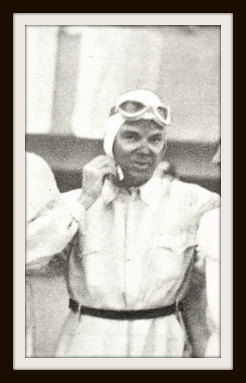
|
|
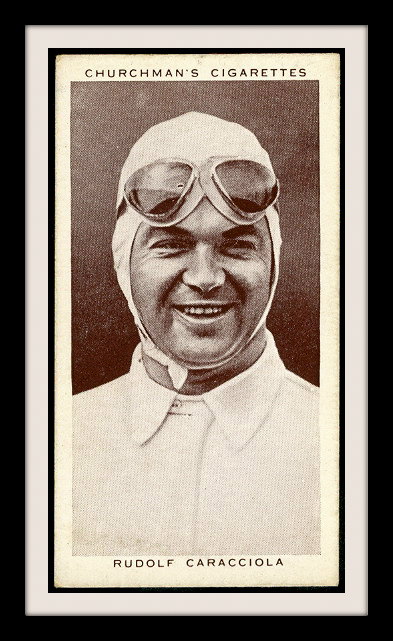
| |
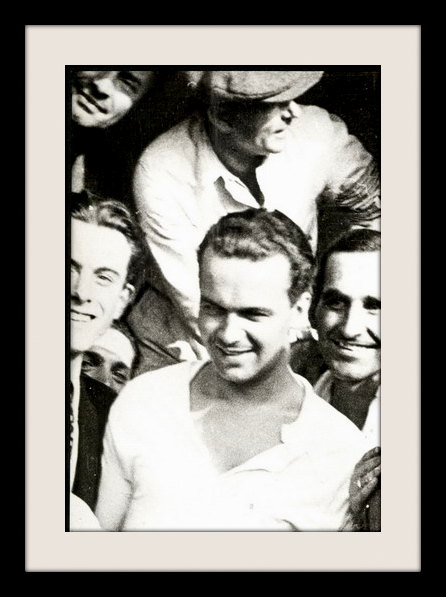
| |